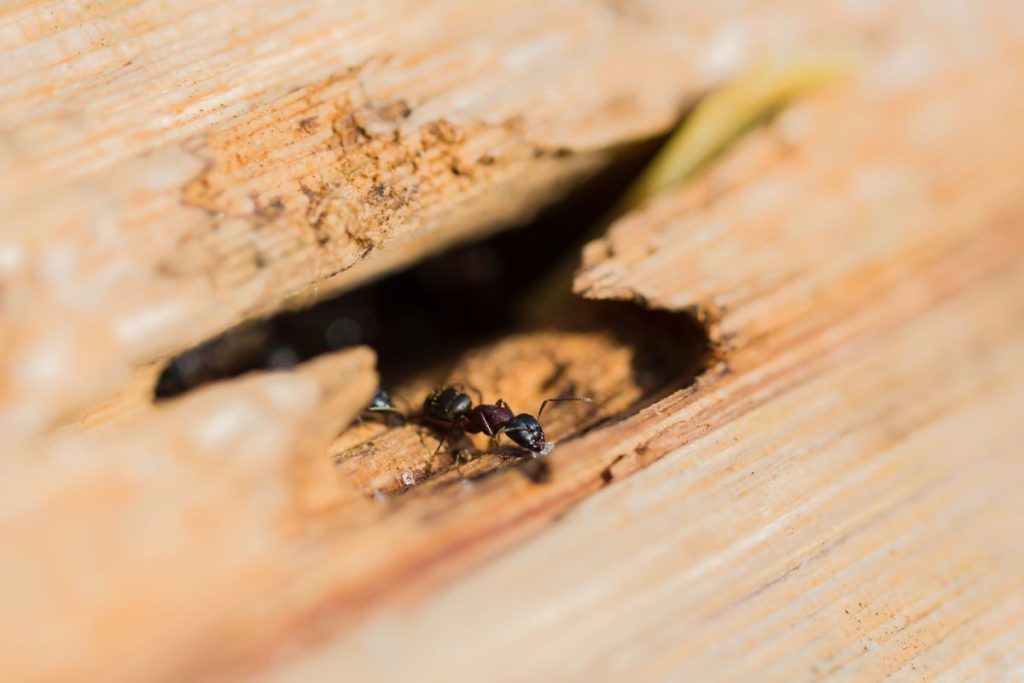Termites will give you some visual, audible, and obvious signs during infestation or the planning of infestation. For example, you will see mud tubes, droppings, sagging panels, and others. Faint clicking or hollow sounds are also common. Live termites, termite holes, frass, and loose cornices or visible structural shifts are some obvious signs.
Termites are a major problem in Singapore due to its moist environment, forest areas, and wooden complex building structures. You can easily identify the early-stage signs of termites in the ceiling to determine an infestation beforehand and take the necessary steps.

10 Common Signs Of Termites In The Ceiling
1. Termite exit holes on the ceiling
Pinholes are created when the termites exit the structure during a nuptial fight in their mating season or when the termites remove waste like fecal pellets or wood dust through those holes. You will see multiple, like more than 20, holes in a specific area or throughout the ceiling drywall. So many holes indicate major damage inside the wood since they have already created a long tunnel under the surface.
2. Clicking noise from termite activity
Termites damage your property with noise. You will hear clicking or tapping sounds coming from the ceiling. It happens when soldier termites bang their heads against a wooden structure to communicate with their colonies or when worker termites chew through wood. Either way, this is a major concern since it can destroy your support structure in Singapore.
3. Sagging ceiling panels
Sagging ceilings are the result of moisture buildup in most cases. However, sometimes, it happens when these wood-eating pests create tunnels and galleries by eating cellulose-rich materials beneath the wood. Checking is important to ensure whether it is done by termites or moisture.
4. Bubbling paint from moisture
Uneven paints or bubbling often result from water damage or excessive moisture buildup. However, hidden mud tubes and termite galleries by drywood and subterranean termites within the ceilings can increase the moisture level and create such bubbling effects. Thermal imaging inspection can identify this infestation.
5. Mud tubes near ceiling joints
Mud spotting or mud patches are common if you have a termite infestation. These termite tubes protect the termite colonies from predators, dry air, and extreme temperatures. Besides, these tubes serve as a communication channel between the colonies. These pests carry food through these tubes a well.
6. Frass or termite droppings below
You will find termite frass, also known as wood pellets or droppings, on the floor. This dust-like frass falls from the ceiling when termites eat wood or create tunnels under the surface. You must look above to check the holes or other indicators to find out the termite infestation.
7. Hollow sounds in wooden beams
Tape your ceiling with a screwdriver or anything hard and check whether you find a hollow sound or not. It is a sign of internal wood decay and indicates that termites have eaten the wood from inside and created hollow spaces as well. Try to push the wood with your finger and see whether it gives in or feels soft.
8. Discolored ceiling from termite galleries
Discolored drywall or dark patches are often associated with moisture accumulation or water damage. However, in some cases, it can result from termite activities since termite galleries or tunnels can disrupt the moisture balance in a wooden structure and discolor the area.
9. Ceiling cracks from termite damage
You can also find Unexplained ceiling cracks that widen over time. It happens due to support structure erosion caused by termites feeding on the wood. Take immediate actions to prevent future damage and avoid costly repairs.
10. Loose or shifted cornices
Termites feed on the cellulose of the cornices, resulting in structural damage from inside and shifting the cornices. You will see your cornices pulling away from the ceiling. People often ignore this until the infestation grows really high.
What to do when you see these signs?
- Look for other signs and ensure termite infestations.
- Do not break the colonies or disturb the area since it will scatter them and make the treatment harder.
- Call a termite specialist in Singapore and fix a schedule for inspection and treatment.
- Apply professional treatments such as soil treatment, thermal, liquid termiticides, baiting systems, or even structural fumigation.
- Repair the structural damage after the treatment.
Need Professional Help?
TERMITE SPECIALIST PTE LTD, the number one termite specialist with 13 years of experience in Singapore, offer an effective termite solution for you. We are NEA & BCA Certified. Call us at +65 6910 3776 or visit our office at 50 Bukit Batok Street 23, #05-30 MIDVIEW BUILDING. Get directions.
Read Our Recent Termite Blogs
13 Years of experience taught us a few things
Signs of Termites in Singapore
Signs of Termites in the Floor in Singapore
Sings of Termites in the Attic
Some Common Questions We Get
Can termites really damage the ceiling structure?
Yes, termites can eat through wooden beams and ceiling joists, causing structural weakness, sagging, and even collapse if left untreated.
What should I do if I suspect termites in my ceiling?
You should contact a licensed termite control professional immediately to conduct a thorough inspection and start treatment if needed.
Are ceiling termite signs different from wall or floor signs?
The signs can be similar—mud tubes, droppings, and hollow wood—but ceilings may also show sagging panels or cracks in unusual spots.
